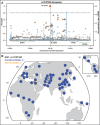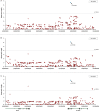Recent Positive Selection Drives the Expansion of a Schizophrenia Risk Nonsynonymous Variant at SLC39A8 in Europeans
- PMID: 26006263
- PMCID: PMC4681542
- DOI: 10.1093/schbul/sbv070
Recent Positive Selection Drives the Expansion of a Schizophrenia Risk Nonsynonymous Variant at SLC39A8 in Europeans
Abstract
Natural selection has played important roles in optimizing complex human adaptations. However, schizophrenia poses an evolutionary paradox during human evolution, as the illness has strongly negative effects on fitness, but persists with a prevalence of ~0.5% across global populations. Recent studies have identified numerous risk variations in diverse populations, which might be able to explain the stable and high rate of schizophrenia morbidity in different cultures and regions, but the questions about why the risk alleles derived and maintained in human gene pool still remain unsolved. Here, we studied the evolutionary pattern of a schizophrenia risk variant rs13107325 (P < 5.0 × 10(-8) in Europeans) in the SLC39A8 gene. We found the SNP is monomorphic in Asians and Africans with risk (derived) T-allele totally absent, and further evolutionary analyses showed the T-allele has experienced recent positive selection in Europeans. Subsequent exploratory analyses implicated that the colder environment in Europe was the likely selective pressures, ie, when modern humans migrated "out of Africa" and moved to Europe mainland (a colder and cooler continent than Africa), new alleles derived due to positive selection and protected humans from risk of hypertension and also helped them adapt to the cold environment. The hypothesis was supported by our pleiotropic analyses with hypertension and energy intake as well as obesity in Europeans. Our data thus provides an intriguing example to illustrate a possible mechanism for maintaining schizophrenia risk alleles in the human gene pool, and further supported that schizophrenia is likely a product caused by pleiotropic effect during human evolution.
Keywords: Europe; SLC39A8; nonsynonymous SNP; pleiotropic effects; positive selection; schizophrenia.
© The Author 2015. Published by Oxford University Press on behalf of the Maryland Psychiatric Research Center. All rights reserved. For permissions, please email: journals.permissions@oup.com.
Figures







Similar articles
-
GWAS-identified schizophrenia risk SNPs at TSPAN18 are highly diverged between Europeans and East Asians.Am J Med Genet B Neuropsychiatr Genet. 2016 Dec;171(8):1032-1040. doi: 10.1002/ajmg.b.32471. Epub 2016 Jun 17. Am J Med Genet B Neuropsychiatr Genet. 2016. PMID: 27312590
-
Differential Natural Selection of Human Zinc Transporter Genes between African and Non-African Populations.Sci Rep. 2015 Apr 30;5:9658. doi: 10.1038/srep09658. Sci Rep. 2015. PMID: 25927708 Free PMC article.
-
Larger genetic differences within africans than between Africans and Eurasians.Genetics. 2002 May;161(1):269-74. doi: 10.1093/genetics/161.1.269. Genetics. 2002. PMID: 12019240 Free PMC article.
-
The highly pleiotropic gene SLC39A8 as an opportunity to gain insight into the molecular pathogenesis of schizophrenia.Am J Med Genet B Neuropsychiatr Genet. 2018 Mar;177(2):274-283. doi: 10.1002/ajmg.b.32545. Epub 2017 May 30. Am J Med Genet B Neuropsychiatr Genet. 2018. PMID: 28557351 Review.
-
The schizophrenia risk gene ZNF804A: clinical associations, biological mechanisms and neuronal functions.Mol Psychiatry. 2017 Jul;22(7):944-953. doi: 10.1038/mp.2017.19. Epub 2017 Mar 14. Mol Psychiatry. 2017. PMID: 28289284 Review.
Cited by
-
Impact of Zinc Transport Mechanisms on Embryonic and Brain Development.Nutrients. 2022 Jun 17;14(12):2526. doi: 10.3390/nu14122526. Nutrients. 2022. PMID: 35745255 Free PMC article. Review.
-
Recent Advances in the Role of SLC39A/ZIP Zinc Transporters In Vivo.Int J Mol Sci. 2017 Dec 13;18(12):2708. doi: 10.3390/ijms18122708. Int J Mol Sci. 2017. PMID: 29236063 Free PMC article. Review.
-
Neuronal SLC39A8 deficiency impairs cerebellar development by altering manganese homeostasis.JCI Insight. 2024 Oct 22;9(20):e168440. doi: 10.1172/jci.insight.168440. JCI Insight. 2024. PMID: 39435657 Free PMC article.
-
SLC39A8.p.(Ala391Thr) is associated with poorer cognitive ability: a cross-sectional study of schizophrenia and the general UK population.medRxiv [Preprint]. 2024 Sep 19:2024.09.18.24313865. doi: 10.1101/2024.09.18.24313865. medRxiv. 2024. Update in: Am J Med Genet B Neuropsychiatr Genet. 2025 Jun 18:e33037. doi: 10.1002/ajmg.b.33037. PMID: 39371177 Free PMC article. Updated. Preprint.
-
The schizophrenia risk locus in SLC39A8 alters brain metal transport and plasma glycosylation.Sci Rep. 2020 Aug 4;10(1):13162. doi: 10.1038/s41598-020-70108-9. Sci Rep. 2020. PMID: 32753748 Free PMC article.
References
-
- Sullivan PF, Kendler KS, Neale MC. Schizophrenia as a complex trait: evidence from a meta-analysis of twin studies. Arch Gen Psychiatry. 2003;60:1187–1192. - PubMed
-
- Owen MJ, Craddock N, O’Donovan MC. Suggestion of roles for both common and rare risk variants in genome-wide studies of schizophrenia. Arch Gen Psychiatry. 2010;67:667–673. - PubMed
Publication types
MeSH terms
Substances
LinkOut - more resources
Full Text Sources
Other Literature Sources
Medical

